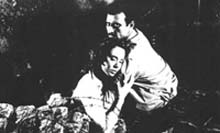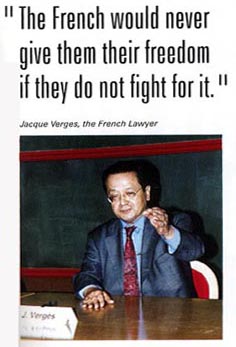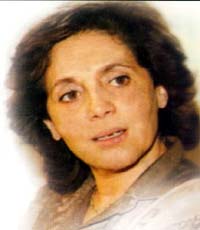|
Djamila Bouhired is considered by many as the most
powerful female freedom fighter of the twentieth
century, but still for vague reasons, very little is
known about this national cum international heroine. In
fact, it seems as if a veil is thrown over and around
Djamila in an attempt to obscure her name and force her
into oblivion.

Information about her part - which was quite significant
- in the Algerian Liberation Revolution consists mostly
of very irrelevant hints here and there. One could find
detailed sources of information about many less
important and less famous freedom fighters. This rises
actually more than a question about the reasons and
motives, since there is barely an Arab town that does
not have a street or a school named after this great
Algerian Woman.
Taking into consideration that she played a vital role,
even after her capture, during her trial and later on
throughout her imprisonment, in the success of the
Algerian Revolution and later on, in promoting the idea
of armed struggle against colonialism, the attempts to
ignore her are well understood. But one feels sad that
even the official departments of the country she fought
for apologize politely for the lack of any information
about Djamila, offering instead information about other
personalities. I felt so bad when an official of an
Algerian Embassy told me that the only thing they have
about this lady is that her name comes in the list of
martyrs!
The story of Djamila starts in fact in the year 1830,
when France conquered Algeria as a result of a slight,
committed by its ruler against a French envoy. The
Algerians fought bravely, but they were unarmed and
outnumbered. In the next five decades, most of their
fertile lands were confiscated and granted to French
settlers whose number reached quarter a million, while
the number of the Algerian People diminished gradually.
A few years before the break of the World War II, France
officially annexed Algeria as an African French
Province. In spite of the Algerian people refusal of the
French step, their youth were forced into military
service to fight for France during the Second World War,
the end of this war proved very bloody for the
Algerians.
Peaceful demonstrations had been taking place for some
months against the unfair treatment of Algerians (an
oft-mentioned example was the reservation of bread for
Europeans, the others only having the right to barley)
and 15,000 people had protested in the streets of
Mostaganem earlier without any incidents. But this was
to change very soon, as in response to street protests
the French Army committed a genocidal massacre at Setif.
On May 8, 1945, a day chosen by the allies to celebrate
their victory over Nazi Germany, thousands of Algerians
gathered near a mosque in Setif for a peaceful march -
for which the Authorities had given permission. It was a
market day. A few minutes later the crowd, chanting
nationalist slogans, came under fire from troops brought
in from Constantine.
The scene soon turned into a massacre - the streets and
houses being littered with dead bodies. Witnesses claim
terrible scenes, that legionnaires seized babies by
their feet and dashed their heads against rocks, that
pregnant mothers were disemboweled, that soldiers
dropped grenades down chimneys to kill the occupants of
homes, that mourners were machine gunned while taking
the dead to the cemetery.
A public record states that the European inhabitants
were so frightened by the events that they asked that
all those responsible for the protest movement should be
shot.
The carnage spread and, during the days that followed,
some 45,000 Algerians were killed. Villages were shelled
by artillery and remote hamlets were bombed with
aircraft.
A Colonel in charge of burials being criticized for
slowness told another officer: “You are killing them
faster than I can bury them.”
The Setif incident and many similar ones taught the
Algerians a very important lesson: The French would
never give them their freedom if they do not fight for
it.
Against this background, Djamila was born and raised
into a middle-class family. She was educated in a French
school but became drawn into the underground nationalist
struggle by her brother. She was at that time a very
dashing young girl with a lot of brains and rare beauty.
During the Revolution she worked as a liaison agent for
the commander Saadi Yacef.
There are also unconfirmed reports that she was at some
time in charge of armed operations in the capital,
Algeria.

The Algerian Revolution of 1954-65 was one of the most
powerful of the post-World War II anti-colonial
struggles that swept Asia and Africa. The first action
of the FLN (National Liberation Front) was a Nov. 1,
1954, guerrilla attack against French forces in the
Aurès mountains of eastern Algeria. This took place just
six months after the French defeat at Dien Bien Phu in
Vietnam - an event that spelled the end of French
domination of Indochina and accelerated the
disintegration of the French colonial empire.
The liberation struggle, which included armed attacks
against all aspects of the colonial regime, won
widespread support among villagers. In the cities, the
FLN quickly won solid backing. The Casbah, a
working-class district in the capital city of Algiers,
where support for the FLN ran high, became famous as a
no-go zone for the imperialist forces. Massive
pro-independence demonstrations swept Algerian cities in
1960, making clear to the French government the
determination of the Algerian people.
France threw the full weight of its modern army,
supplied with the latest weapons from NATO against this
liberation struggle. In the seven-and-a-half-year war
more than 400,000 French troops-including almost
two-thirds of the air force and half the navy- were
engaged in the war. The French also used the most
refined counterinsurgency methods. In addition to
planes, tanks, and a naval blockade, they used
electrified barriers to seal off the borders of Tunisia
and Morocco, operated dragnets to isolate the rebels,
and wiped out more than 8,000 villages in a
scorched-earth policy. They employed the most
sophisticated and diabolic methods of terror, espionage,
and torture in the attempt to smash the liberation
movement.
Casualties were extremely high. Two and a half million
people were displaced as a result of the war, and more
than a million deaths were directly attributed to it.
More than 300,000 orphaned children flooded the cities,
while 300,000 other Algerians were driven into Tunisia
and Morocco, where they became an additional base of the
liberation struggle.

Djamila Bouhired was destined to be one of those
casualties. She was captured in a raid and accused of
planting bombs responsible for many deaths in French
restaurants in Algiers. After considerable torture she
was tried, convicted and sentenced to death in July
1957.
But her French lawyer, a strong believer in the right of
self-determination of peoples, was not ready to concede
defeat in the comic trial. Jacque Verges, the lawyer,
who later on won international fame for his role in
Djamila’s and other cases, waged a public relation
campaign that reached even the remotest village all over
the world. Under the overwhelming pressure of world
public opinion, the execution was postponed, and in 1958
she was sent to the prison in Rheims.
After many defeats and following huge losses of life for
both sides, the Evian Agreements were signed in May
1962, proclaiming the independence of Algeria. However,
a few months earlier, while negotiating the agreements,
France began gradually releasing the thousands of
Algerian prisoners. When Djamila was released, and
within a short period, she has married her lawyer who
embraced Islam and took the name of Mansoor.
After the independence, Djamila became the Chairwoman of
the Algerian Women Association, but she had to fight an
uphill battle for every single resolution with the then
president, Bin Bella. It took her a couple of years to
decide that enough was enough, and to leave the
political arena. She continues to live in Paris as a
devoted housewife, but at the same time, her very rare
public appearances have proved that the world still
regards her as the symbol of national liberation.
| 